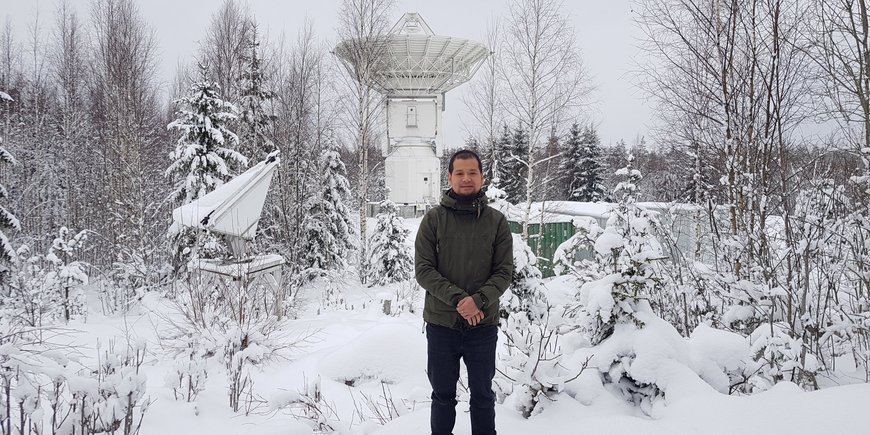The project “Astrogeodesy” has received €1.5 million of funding from the European Research Council (ERC) to improve the performance of the next-generation geodetic VLBI system called VLBI Global Observing System (VGOS).
Why improve very long baseline interferometry?
For a long time, human beings observe celestial objects for navigation and timing. Observations of far distant objects remain as the unique means to measure the irregular Earth rotation with high precision.
Earth rotation is characterized by its angular speed (length of day) and by the position of the rotation axis both in space and in a frame tied to Earth. Its variations are caused by planetary forces, primarily the Sun and the Moon, and mass changes in the oceans, hydrosphere, atmosphere, mantle, and core of the Earth. These observations are routinely made by very long baseline interferometry (VLBI) which measures variations in the length of day to a few millionths of a second and the orientation of the rotation axis to a few billionths of a degree.
The measured variations in Earth rotation by VLBI provide an essential support for many satellite missions such as the global navigation satellite systems (GNSS), like the American GPS or the European Galileo. As there is no backup technique to VLBI, it provides an indispensable information for a multitude of activities in our daily life and of course is the basis of research in many fields of geosciences.
In addition to improving regular measurements of the Earth’s rotation with high accuracy, the goal of VLBI Global Observing System is to realize an accurate and stable terrestrial reference frame, with which the dynamical processes in the solid Earth, such as global hydrological cycle, earthquake, tectonic deformations, landslides, or deglaciation, can be monitored on various time scales. This importance has also been recognized in a resolution recently adopted by the United Nations General Assembly and promoted by the UN Global Geospatial Information Management Initiative and its Subcommittee on Geodesy. Considering this importance, it needs to be continuously improved. Dr. Minghui Xu, who received the funding and will establish the project at the GFZ with a smaller share at Technical University of Berlin, highlights how: “As both the potential in terms of precision and the goal of VGOS has advanced by one order of magnitude to mm-accuracy on global scales, it is required to develop a new data calibration concept and method for this system – especially we need to embrace the celestial objects that we observe.”
How to improve very long baseline interferometry?
Over the past 20 years of designing the VGOS system, it was thought that the atmosphere was the dominant error source and hence considerable efforts have been invested to model and correct its impact on radio signals. However, in more recent years, partly thanks to the pioneering work of Minghui Xu, it has become clear that the challenge of achieving VGOS goal is the understanding of the true structure of the celestial objects, typically quasars, which are not ideally point-like.
About 30 VGOS antennas have been or are being built across the world, and regular VGOS observations are carried out with the completed antennas. It is urgent to unfold the VGOS data, and fortunately the structure images of celestial objects that Minghui Xu has obtained from these data are an excellent basis for the upcoming research project. The Astrogeodesy project will connect the three disciplines of geodesy, astrometry, and radio astronomy to solve the challenge. The project will start in May 2023 and last for five years. A new working group under the name of the project will be established at Section 1.1, Space Geodetic Techniques.
About Minghui Xu
Minghui Xu studied geodesy in Wuhan University for his bachelor and astrometry in Shanghai Astronomical Observatory (SHAO) for the master. For the PhD, he started the research about VLBI jointly at SHAO and the GFZ with the support of DAAD. He made the defense in 2015, and subsequently worked as a postdoc at the GFZ and a research fellow at SHAO. In 2018 Technical University of Berlin appointed him as a Mercator Fellow. After shortly working at Huazhong University of Science and Technology in China, he joined Aalto University in Finland to work at Metsa̎hovi Radio Observatory as a research Fellow in 2019 and moved back to the GFZ in September 2022.
About the ERC Grant
The ERC, set up by the European Union in 2007, is the premier European funding organisation for excellent frontier research. It funds creative researchers of any nationality and age, to run projects based across Europe. The ERC offers four core grant schemes: Starting Grants, Consolidator Grants, Advanced Grants and Synergy Grants. With its additional Proof of Concept Grant scheme, the ERC helps grantees to bridge the gap between their pioneering research and early phases of its commercialisation. The ERC is led by an independent governing body, the Scientific Council.










![[Translate to English:] Torsten Sachs in front of a climate station on a field](/fileadmin/_processed_/3/9/csm__TorstenSachs_bearbeitet_GS_4a1365ef84.jpeg)

![[Translate to English:] left image flood at the Ahrtal: image from above, several houses are flooded; left image:: Heidi Kreibich;](/fileadmin/_processed_/4/4/csm_Bild2_9af0130e9f.png)



![[Translate to English:] Start der Vega Rakete](/fileadmin/_processed_/6/4/csm_20231201-kachel_Vega-VV23-launch_ESA-CNES-Arianespace_706716b68c.jpeg)









![[Translate to English:] Poster exhibition at the Brandenburg Hydrogen Day at the GFZ, some participants in the foreground](/fileadmin/_processed_/6/5/csm_Erster_Brandenburgischer_Wasserstofftag_GFZ_402fcec95e.jpeg)
![[Translate to English:] Group picture of the participants](/fileadmin/_processed_/9/4/csm_20231108_CAWa-Workshop-Tashkent_Gruppenbild_99ea779d8a.jpeg)

![[Translate to English:] [Translate to English:] Hörsaal](/fileadmin/_processed_/e/6/csm_H%C3%B6rsal_e21ac645fb.jpeg)


![[Translate to English:] The Delegations in the Historic Library on the Telegrafenberg. In the back there are from left to right, the Dutch Ambassador for Germany, Ronald van Roeden, the Dutch Minister for Education, Culture and Science, Robbert Dijkgraaf and the scientific director of the GFZ, Susanne Buiter.](/fileadmin/_processed_/d/b/csm_Kachel-2_9eba4b4212.jpeg)

